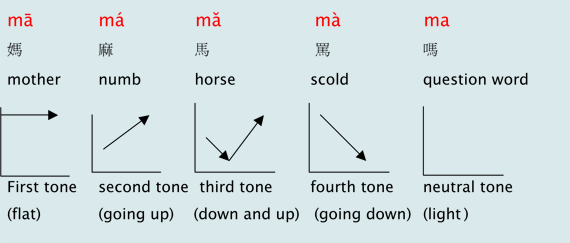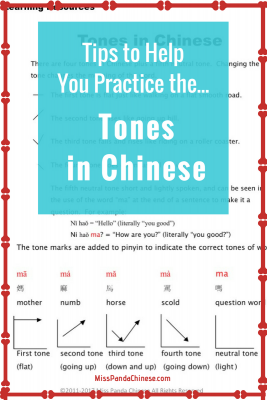
Tones in Chinese by Miss Panda Chinese
Learning Chinese tones with ease! Many parents and adult learners with no Chinese language background ask about how to pronounce Chinese words correctly with different tones when learning Mandarin Chinese with their kids. There are three steps to follow when you are learning Chinese tones.
First, relax and smile
Trust me, relaxation is the key for adults when we learn to speak a new language. Relax! Deep breath. A smile works like magic and it makes you relaxed. Here you are ready to learn Chinese tones or practice Chinese tones.
Second, sing
Sing a simple Chinese children’s song together! Singing a children’s song is a great way to start and practice. You can also try songs with a lot of repetition, like the Chinese song, “Sorry, my Chinese is not so good” by three British gentlemen.
Third, listen
Listen, listen, and listen to Chinese songs, short tongue twisters, stories,…! The more Chinese listening input you have the better. When you listen to Chinese it is passive learning (input). When you speak Chinese it is producing (output). You need a lot of input in order to have output, however, many learners miss this key point. Listening is the key to practice not just the tones but the Chinese language from the start to the advanced level.

In addition to all of the above, I want to share with you a simple and fun way to acquire and remember the tones in Mandarin Chinese. I’ve created the Roller Coaster method for acquiring Mandarin Chinese tones. It works like a charm for my students (including adults) to practice Chinese words in different tones. We move our hands in the air, have our heads go up and down, and laugh a lot when we do the tone practice. You will not use the head movement after the introductory stage but you will keep the laughter. The key here is the more fun you have the easier for you to internalize and acquire the tones. In context – not just simple words.
It is always okay to make mistakes and make funny twisted tones. It is how we learn. I always tell students to make the sound of each word longer so he/she can hear it. The point is if you cannot hear yourself saying the words clearly then others cannot hear you, either. This applies to all languages, not just Mandarin Chinese.
Some people speak fast and some people speak slow. Let’s start slow and speed up later when we feel comfortable with each tone.
Ready? Here we go!
There are four tones in Mandarin Chinese along with a fifth neutral tone. Changing the tone changes the meaning of a word that has the same sound. That is why tones are very important in the Chinese language. I have a collection of fun cards with fun phrases/short sentences for students to practice tones with. I always encourage the students to visually see the pictures in their heads. We always laugh so hard and it sticks to them. “Stickiness” comes with your visualization of what we are talking about here.
Here are two phrases for you. You want to order “dumplings” 水餃 |水饺 shuǐ jiǎo NOT “sleep” 睡覺|睡觉 shuì jiào. You will take an “airplane” 飛機|飞机 fēi jī to see your grandma NOT a “fat chicken” 肥雞|肥鸡 féi jī!
Now, listen to the four phrases. ***CORRECTION in the audio: “to sleep,” the two Chinese characters “shuì jiào” are both 4th tone and are going DOWN (not up).***
Let’s look at the tones. In the chart below, the tone marks are added to pinyin (top in red) to indicate the correct tones of words. This is a visual for you to have an idea. When you speak you don’t need to refer to this at all. Why? Because we will listen actively and respond (speaking).

Tones in Chinese by Miss Panda Chinese
The first tone is flat just like heading out on a roller coaster ride or you can say it is like walking on a flat smooth road.
The second tone rises like going up hill on a roller coaster.
The third tone falls and rises like riding on a roller coaster.
The fourth tone goes down fast all the way.
The fifth neutral tone is short and lightly spoken and can be seen in
the use of the word “ma” at the end of a sentence to make it a question. It is like a quick punch – short and light.
For example:
Nǐ haǒ = “Hello” (literally “you good”)
Ni ̌haǒ ma? = “How are you?” (literally “you good?”)
The introduction of tones in Mandarin Chinese is included in the “Let’s Learn Mandarin Chinese with Miss Panda!” CD/MP3 album – the Welcome track. Got a question for Miss Panda? Leave a comment or send a message to Miss Panda via Facebook or email.
When we talk about Chinese tones we will also check in with where we are with PINYIN. I have curated some good resources in Chinese Toolbox for you below so you can practice and get even better!
Chinese Toolbox: Zhuyin. Pinyin. Audio support.
ㄅㄆㄇㄈ zhuyin with audio for all ages
Mandarin Chinese Pronunciation Guide (FREE printable download)
Pinyin with audio for kids
Pinyin with audio for big kids and adult learners
Learning Chinese tones | Chinese Toolbox: Tips to Help Your Practice the Tones in Chinese with Audio | Tones in Mandarin Chinese
it is very important to learn the Chinese tones correctly otherwise the chances of mistakes increase during your speaking. thank you for this very interesting blog post.
There are different Chinese characters with same or different tones, therefore, it is important to say the words or phrases correctly. However, it is important to know that the more learners hear and the more learners practice the better they will get.